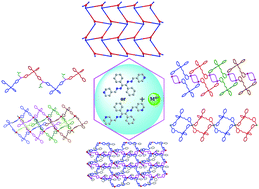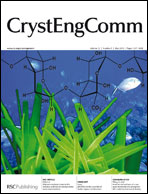A series of metal–organic frameworks {[AgL1]ClO4}n (1), {[AgL12]BF4}n (2), {[AgL1(NO3)](CH3CH2OH)}n (3), {[ZnL12(NCS)2]CH3CN}n (4), [AgL2(NO3)]n (5), {[FeL22Cl2]·CH3CN}n (6), {[MnL22(NCS)2]·(CH3CH2OH)}n (7) and [ZnL22(NCS)2]n (8) have been synthesized and structurally characterized by IR spectroscopy, UV spectroscopy, thermogravimetric (TG) analyses, luminescent spectroscopy and complete single-crystal structure analyses, where L1 is (N′,N′-bis[1-(pyridin-4-yl)methylidene]benzil dihydrazone) and L2 is (N′,N′-bis[1-(pyridin-3-yl)methylidene]benzil dihydrazone), respectively. The structure of 1 exhibits a two-dimensional layer network featuring trimetal 36-membered non-planar macrocycles. Polymer 2 is a one-dimensional chain structure with tetranuclear metallacyclic rings. For polymer 3, each ligand acts as a bidentate ligand to bind two Ag(I) centers and each silver center is coordinated to two N-donors from two ligands forming a one-dimensional chain. Polymer 4 displays a two-dimensional layer network containing tetranuclear 68-membered metallocyclic rings. Polymers [AgL2(NO3)]n (5), {[FeL22Cl2]·CH3CN}n (6), {[MnL22(NCS)2]·(CH3CH2OH)}n (7) and [ZnL22(NCS)2]n (8) show all one-dimensional chain structures containing bimetallic 8-membered rings and tetrametallic 42-membered rings for 5, bimetallic 34-membered quadrangular rings for 6 and 7, and bimetallic 30-membered quadrangular rings for 8, respectively. The luminescent properties of L1, L2 and 1–8 in the solid state were investigated.


 Please wait while we load your content...
Please wait while we load your content...